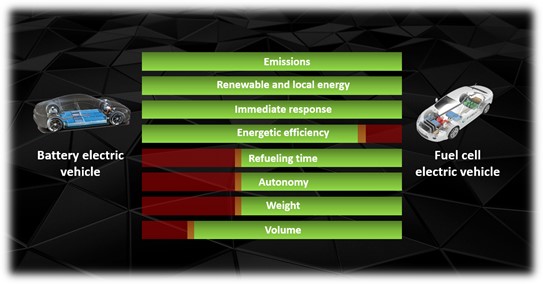Asia has been the main driver of technological advances in this field, focusing on the development of batteries for hybrid and 100% electric vehicles. At present, China dominates both the world battery market and the transformation of the raw materials required for their manufacture. As a result, Western countries find themselves with a high technological dependence that promotes the exploration of the potential of other energy technologies with which they can profitably extend emission-free transportation.
In this context, the opportunity arises to promote research on hydrogen and hydrogen fuel cells as an energy source for the new generations of electric vehicles. Despite the barriers beforehand related mainly to the CO2 emissions generated in the usual processes of obtaining hydrogen from natural gas reforming, the obstacles related to its high-pressure storage and transport, or the investments required to build the supply infrastructures, hydrogen would offer significant advantages in its application in the mobility sector:
-The range of autonomy of hydrogen vehicles is similar to that of traditional combustion vehicles. With this range, hydrogen vehicles overcome one of the main obstacles to the acceptance of electric vehicles, whose average range of autonomy is currently lower.
-The time required to refuel a hydrogen car is also comparable to that of traditional combustion vehicles, so, in this respect, hydrogen vehicles would far outweigh the disadvantages associated with the refueling time of electric vehicles.
-In addition, the likelihood of an accident related to a fuel leak in a hydrogen vehicle is comparable to that of one powered by a traditional combustion engine. That happens because H2 molecules are extremely light and, despite diffusing over almost any surface, they disperse very quickly in the atmosphere.

Due to these advantages and the eagerness of vehicle manufacturers to transform the sector towards a more sustainable model, the commitment to hydrogen technology is being reinforced. As a result of this ambition for change, alliances are being formed between different companies to develop new hydrogen fuel cell architectures and to develop extended-range electric propulsion systems based on hydrogen fuel cells as an auxiliary energy source.
In addition, a lot of research is being done on obtaining hydrogen in a more sustainable way, such as from the electrolysis of water using renewable energy sources, one of the known generation processes for obtaining “green hydrogen”.
Some of the barriers to overcome in this area are the limitations related to the efficiency and durability of fuel cell systems for mobility. These aspects, together with current low production volumes, mean that the cost of hydrogen vehicles is currently very high.
At Grupo Antolin, we have been collaborating for some time in this transition towards sustainable mobility through hydrogen by developing, among other activities, processes for obtaining carbon nanofibers for use in the manufacture of hydrogen fuel cells. The nanofibers generated in our processes are characterized by their excellent properties of electrical conductivity, corrosion resistance, and high specific surface area compared to other carbon substrates traditionally used, making them a base material with great prospects for hydrogen applications. In addition, Grupo Antolin’s nanofibers contribute to improving the efficiency of the electrochemical process of batteries by achieving ten times less in-service degradation using half the platinum of other commercial systems.
We are currently continuing to strengthen this line of research to support our industry in this initiative and bring this revolutionary transformation towards more sustainable mobility within everyone’s reach.
